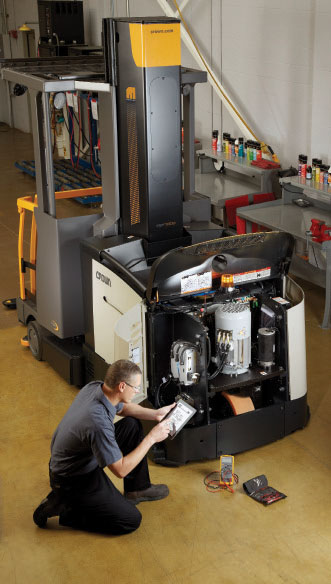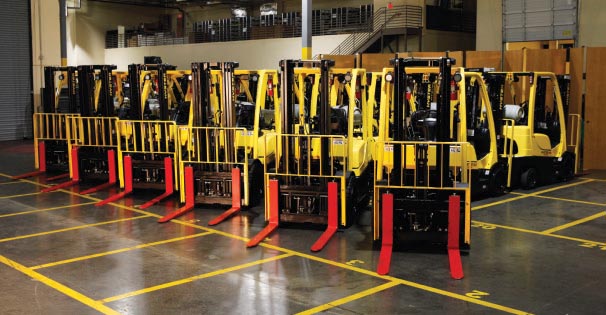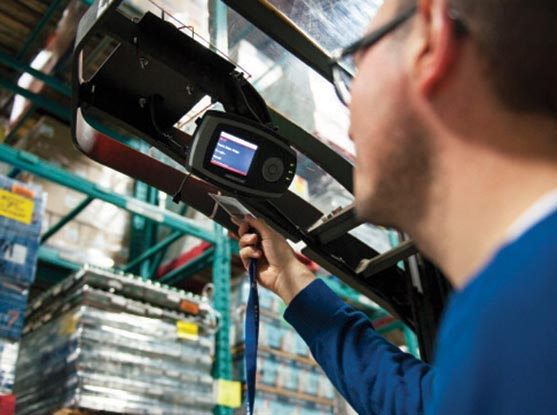Lift Truck Equipment: Telematics on Home Turf
Having evolved from a pure maintenance focus, fleet telematics systems are working to perfect the basics.
Maintenance costs like battery abuse, engine failures and operator damage can be avoidable, but it can be hard to avoid costs that are simply unknown. Telematics solutions can help uncover your facility’s true usage patterns by collecting and interpreting baseline data. By blending the data with related systems, forklift managers can significantly reduce maintenance costs and establish more control over them. Optimal fleet management practices eliminate unknown costs, but can help move your facility from reactive to predictive maintenance.
Aside from the cost savings, the most important benefit of measuring, tracking and using data is an increase in efficiency, which, in turn, improves the productivity of fleets. As a result, lift trucks will be available to produce for a longer period of time, positively impact the bottom line and further offset maintenance costs.
Real-time forklift maintenance data
To better understand their forklift maintenance needs—while also identifying available opportunities for efficiency gains and cost savings—Jim Gaskell, director of global technology and business development for Crown Equipment, advises forklift managers to consistently track their maintenance history. At the same time, Gaskell also believes facilities should establish a benchmark for their forklift maintenance costs, which tend to fluctuate considerably.
“Fleet managers risk ‘spinning their wheels’ if they enter into this process or start to make changes to their maintenance programs without understanding their good operating numbers compared to the bad ones,” Gaskell says.
 With this in mind, he recommends forklift users to collect maintenance data across their fleets, and then compare their findings according to their various departments, locations and models. In doing so, managers will have a much better understanding of their equipment’s total cost of ownership.
With this in mind, he recommends forklift users to collect maintenance data across their fleets, and then compare their findings according to their various departments, locations and models. In doing so, managers will have a much better understanding of their equipment’s total cost of ownership.
Pat DeSutter, vice president of fleet, service and aftermarket for Hyster, agrees with this sentiment and believes that maintenance costs should be categorized so users can manage them more efficiently.
“Repairs may be needed because of normal wear and tear on the equipment, or they could be needed due to misuse of equipment,” DeSutter says. “It is important to understand why damage to the equipment occurred, and then categorize and break it down into what type of repair is needed.”
Although a variety of methods are available to collect this type of information, a work order management system is the most common. Oftentimes, the systems are dedicated platforms that track all assets and associated activities, or they are managed through databases and spreadsheets.
As a more efficient and accurate alternative to manual spreadsheets, forklift users can also use telematics to better manage maintenance costs and utilization data. A data point as basic as hours of usage can ensure planned maintenance is performed only when necessary. In addition to managing trends over time, these systems provide actionable data on demand. According to John Rosenberger, manager of iWarehouse Gateway and global telematics for The Raymond Corp., telematics can automatically collect utilization data and provide users real-time information.
“This reduces the heavy labor and probability for clerical error involved with manual data collection, and users can easily see when service appointments need to be scheduled,” Rosenberger says. “Afterward, telematics can also incorporate cost analytics to show the true costs of forklift ownership.”

Integrated data reduces costs
According to Gaskell, operator misuse often represents 30% to 40% of all operating costs. To help minimize misuse, forklift managers should use a system that identifies and separates misuse from general maintenance items. By using telematics, forklift stakeholders including the end users, equipment manufacturers and service managers can analyze data on site or remotely to ensure all service elements work in unison.
“These options also allow OEMs to see which specialized service or capabilities may be needed in different environments, saving time in service appointments,” Rosenberger explains. “And, they also help them build better customer relationships because they are less likely to charge customers for unnecessary repairs.”
As managers collect a combination of telematics and maintenance cost data, they can identify potential issues more easily and then acquire insights that help prevent them in the future. For instance, fleet data can reveal if usage costs vary from one application or facility to another—and why. If costs do vary, forklift users may need to investigate their operating environments and verify whether costs are avoidable or legitimate maintenance expenses.
Forklift managers may also choose to collect repair data through integrated processes with service providers. As a result, users can identify the relationship between usage and repair costs to better understand their actual costs per hour.
“Combining data recorded on the lift truck with data recorded externally gives the manager a full picture and allows them to make more accurate decisions, thereby helping to drive value,” DeSutter says. “But when you don’t have telematics, the picture can be vaguer, and determining the root cause can be more difficult.”
He adds, “Personalizing the truck to the operator, understanding the nature of the usage and creating an accountability process allows you to make more accurate decisions, and can reduce costs in the long run.”

Predictive service approaches increase uptime
To centralize service management and compare and benchmark their service costs more efficiently, many forklift managers use fleet management systems. In addition to fleet usage data and maintenance costs, these broader systems might incorporate labor management and visibility into other assets. From basic hour meters to fleet right-sizing, fleet managers expect data to be presented in a concise manner. With actionable, real-time and relevant data, users can advance their service management practices from a reactive, “break-fix,” model to predictive service approaches that can increase uptime and prevent avoidable costs.
“Uptime tends to rise as planned maintenance is executed in a disciplined and consistent manner across the fleet,” Gaskell says. “Not to mention, the predictive service approaches can also ensure common forklift maintenance issues are tracked and fixed before they become a serious problem that can cause operator injury or forklift downtime.”
Telematics and maintenance cost tracking offerings are increasingly offered through Web-based portals or other software as a service (SaaS) models. As a result, users no longer have to pay for their entire systems upfront, but can pay for them on a monthly basis.
“Therefore, telematics purchases are transitioning from a large capital investment to an operating expense,” Rosenberger says. “Users will then be able to clearly see trends, anomalies and costs, allowing them to better foresee potential problems and be proactive in their maintenance.”
Organizational elements of maintenance programs
Effective forklift maintenance programs tend to have two critical elements, Gaskell says, highly trained and qualified maintenance personnel, and well-organized record keeping. However, Gaskell has found that most in-house maintenance departments either don’t have an effective record keeping system, or simply don’t use it often enough. Either way, their processes or incentives to track their data properly are often lacking.
“Maintenance departments need to have a commitment to good record keeping,” Gaskell stresses. “Just as importantly, they should also have an understanding of how they can use tracked and gathered maintenance data to enhance their maintenance programs long term.”
Forklift managers should also fully use their telematics systems by acting on the data they collect, primarily focusing on whichever needs have to be addressed at a specific time. Rosenberger actually compares an investment in telematics to purchasing a gym membership—“if you don’t do anything with it, you are wasting your time and money.”
Aside from investing in telematics, Rosenberger believes forklift managers should ensure their maintenance programs are offering highly efficient dispatch time tracking, so potential issues can be solved quickly and forklifts can achieve their full potential.
“Consolidated billing should be offered so that individual invoices don’t need to be sorted through manually,” Rosenberger says. “Instead, customers must be able to see the bigger picture of multiple repairs—with the option of getting down to the details of each invoice, if needed.”
As a final organizational element of effective maintenance programs, DeSutter recommends facilities become more involved. Although the importance of third parties serving as fleet management partners can’t be understated, it is equally important for users to remain fully engaged throughout the entire maintenance process.
“Collaborating with service providers to reduce costs is very beneficial, as they have the expertise to understand utilization and other maintenance factors,” DeSutter adds. “But they are only one element of the equation. You should always be informed and involved as well.”
Companies mentioned in this article:













